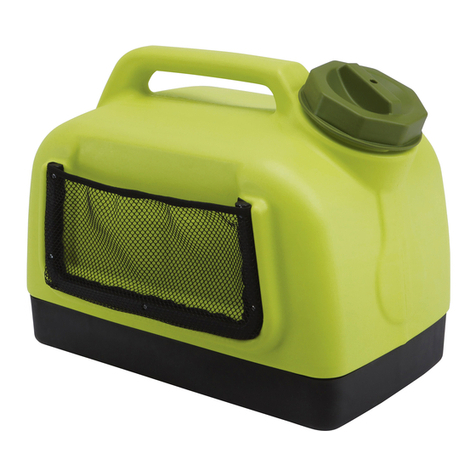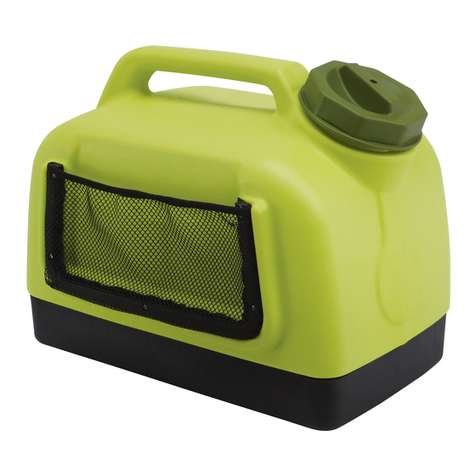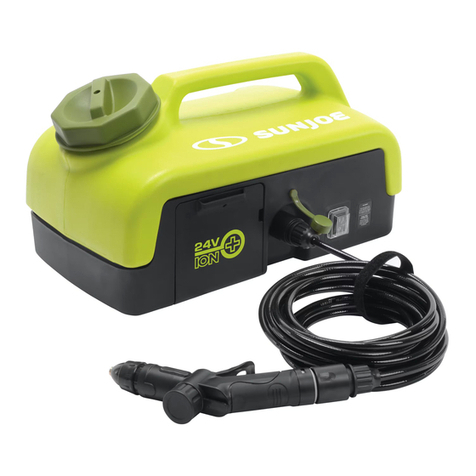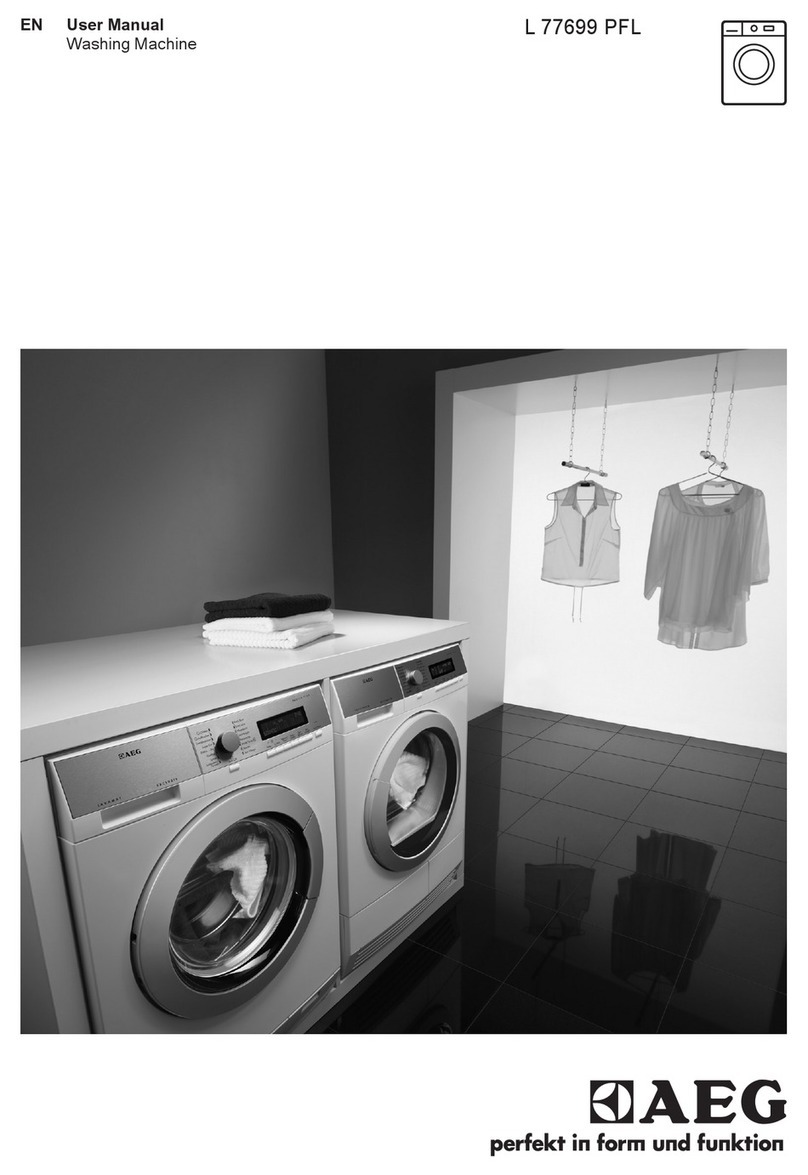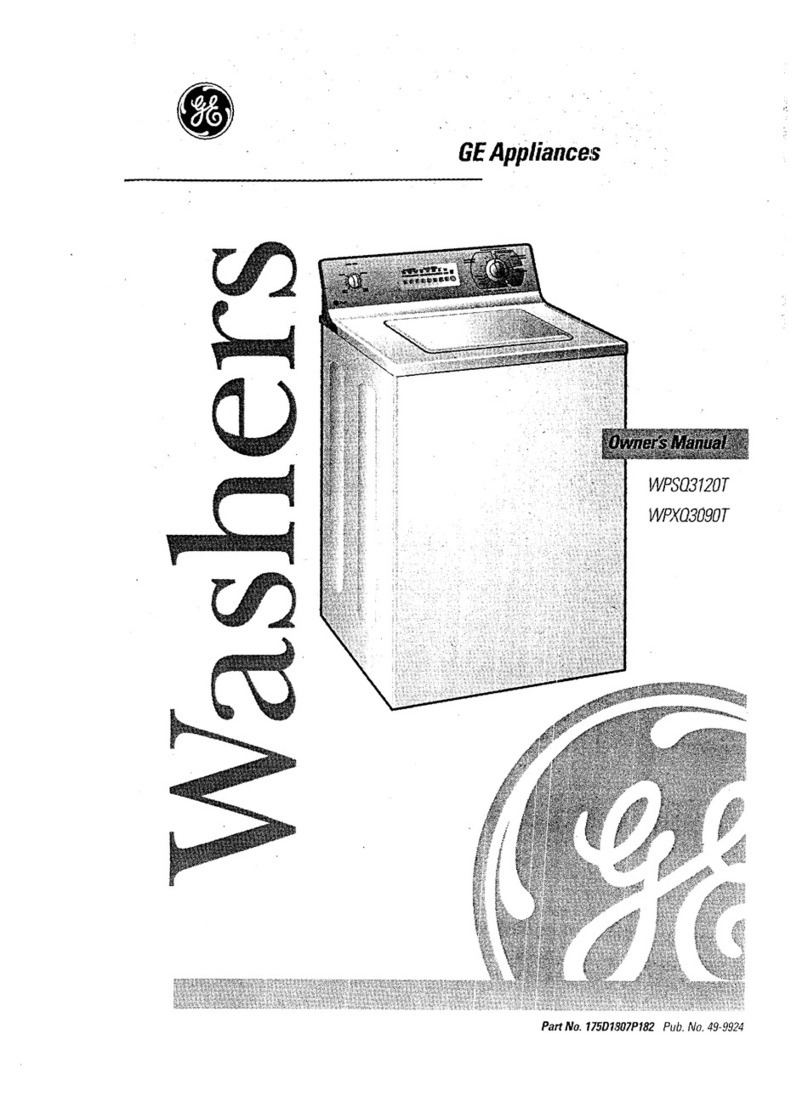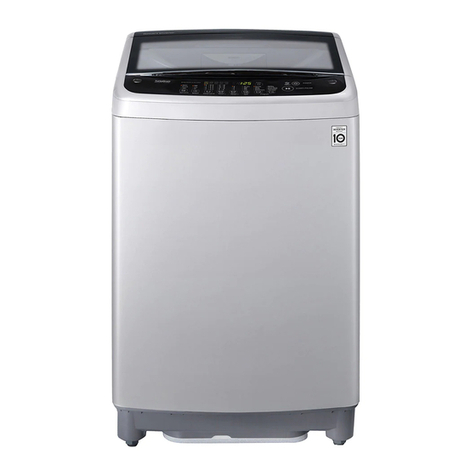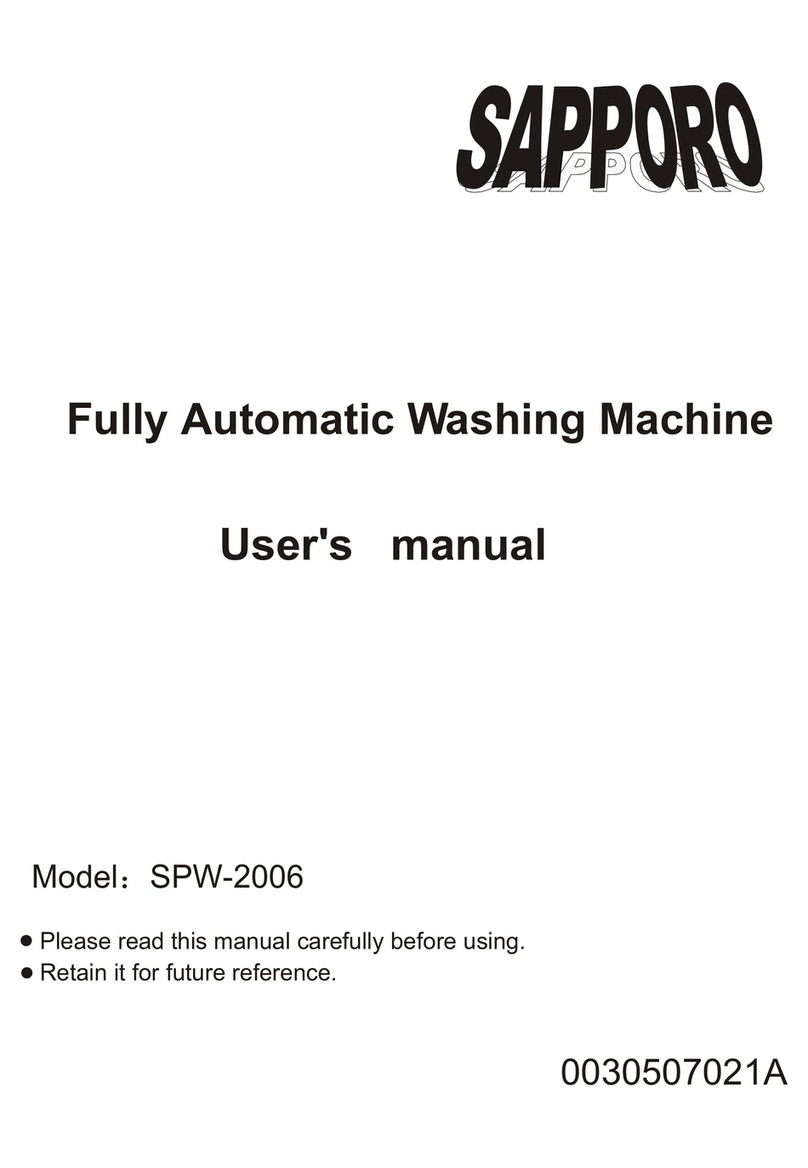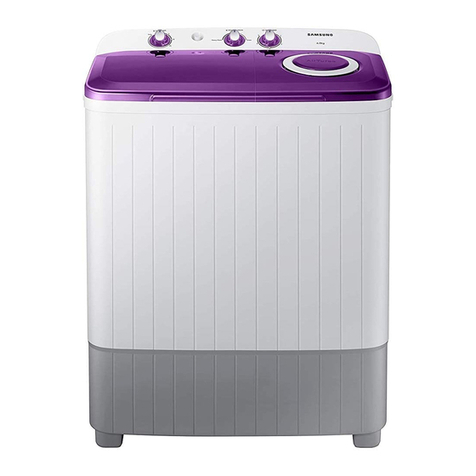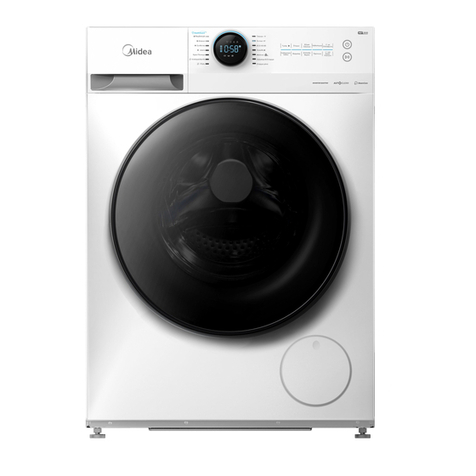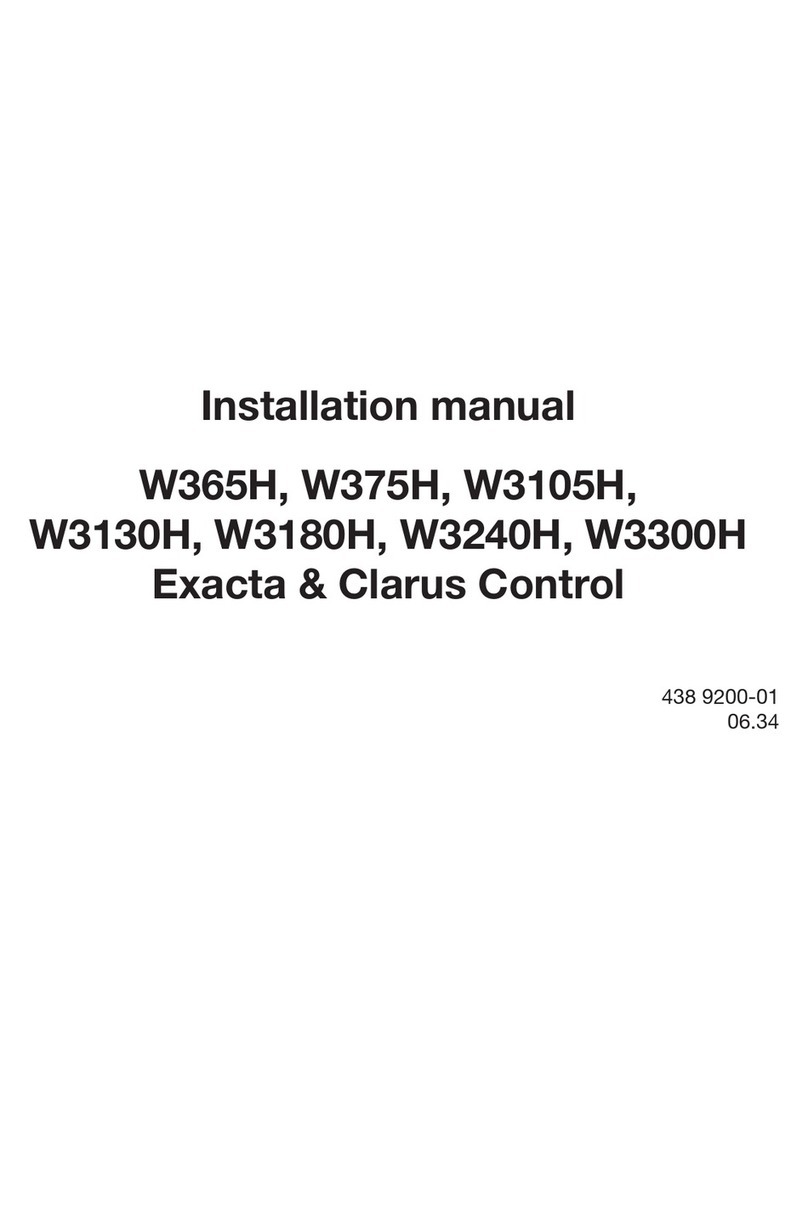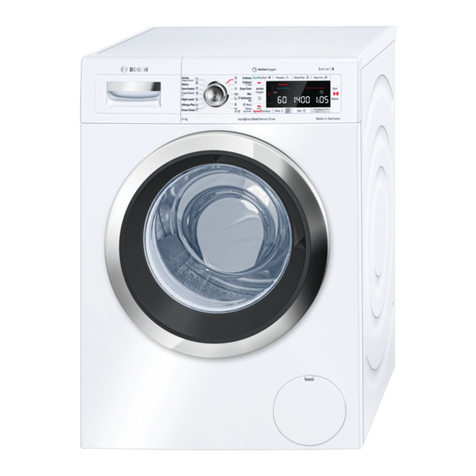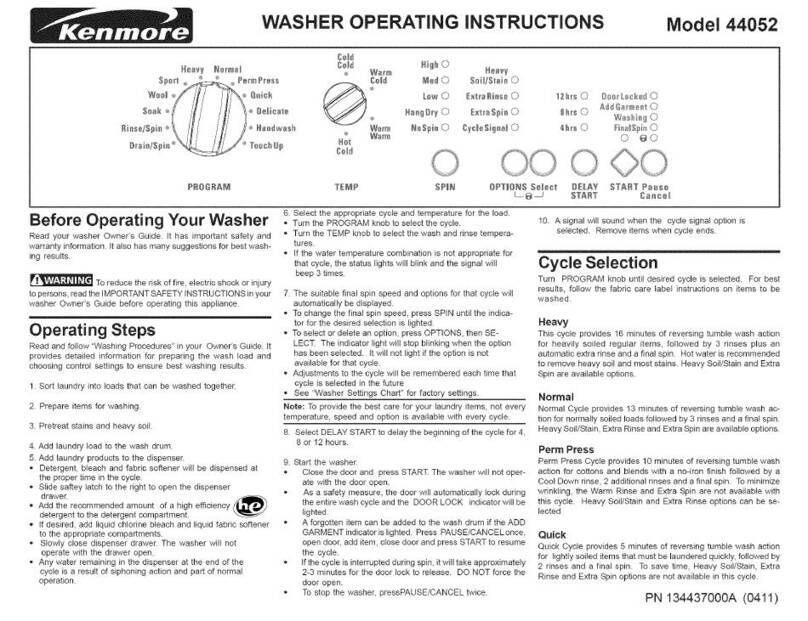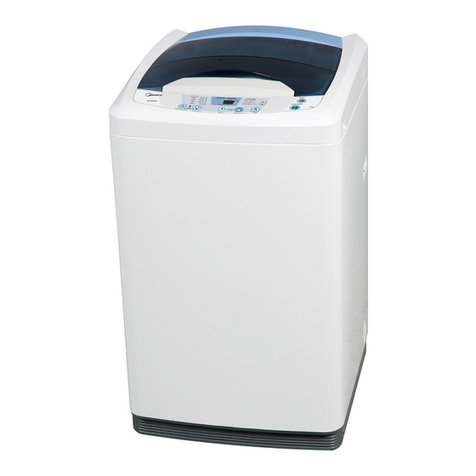SNOWJOE sunjoe 24V-PSW25 User manual

© 2021 by Snow Joe®, LLC
All rights reserved. Original instructions. SAVE THESE INSTRUCTIONS
1
EN
A Division of Snow Joe®, LLC
R
OPERATOR’S MANUAL
24V MAX*2.5-GAL PORTABLE SPRAY WASHER
116 PSI MAX PRESSURE AT INITIAL DISCHARGE PER CSA INTERNAL PRESSURE TESTING
1.5 GPM MAX FLOW WITH NOZZLE OPEN AT MINIMUM PRESSURE
Model 24V-PSW25 Form No. SJ-24V-PSW25-880E-MR2
IMPORTANT!
Safety Instructions
All Operators Must Read These
Instructions Before Use
mWARNING! This indicates a hazardous situation, which,
if not avoided, could result in death or serious injury.
mCAUTION! This indicates a hazardous situation, which,
if not avoided, could result in minor or moderate injury.
mDANGER! This indicates a hazardous situation, which,
if not followed, will result in death or serious injury.
General Safety
mWARNING! This appliance is not intended for use
by children or by unassisted, unsupervised persons whose
physical, sensory, or mental capabilities prevent them from
using it safely. Children should be supervised to ensure that
they do not play with the appliance.
Before starting up your machine, please check it carefully for
any defects. If you nd any, do not start up your machine.
Contact your authorized Snow Joe®+ Sun Joe®dealer or
call the Snow Joe®+ Sun Joe®customer service center at
1-866-SNOWJOE (1-866-766-9563).
mWARNING! When using the spray washer, basic safety
precautions should always be followed to reduce the risk of
re, electric shock, and personal injury. These include:
• Know your product – Know how to stop the machine and
bleed pressure quickly. Thoroughly familiarize yourself with
the controls.
• Keep bystanders away – All visitors and pets should be
kept a safe distance away from the work area.
• Use the right product – Do not use this machine for any
job except that for which it is intended.
• mCAUTION! – Exercise caution to avoid slipping or falling.
Wear protective footwear that will protect your feet and
improve your footing on slippery surfaces.
• Stay alert – Watch what you are doing. Use common
sense. Do not operate the spray washer when you are tired,
or under the inuence of alcohol or drugs.
• Do not overreach – Keep proper footing and balance at
all times.
• Avoid unintentional starting – Do not carry the spray
washer with your nger on the switch. Make sure the switch
is o before inserting the battery.
• Check the water temperature – This spray washer is not
meant to pump hot water. NEVER ll it with hot water as it
will signicantly reduce the life of the pump.
• Store indoors – NEVER store the spray washer
outdoors or where it could freeze. The pump could
be seriously damaged.
mWARNING! Do not use this appliance without reading
this instruction manual.
mWARNING! Do not use the appliance within range of
other people unless they are wearing protective clothing.
mWARNING! High-pressure jets can be dangerous if
subject to misuse. The jet must not be directed at persons,
pets, live electrical equipment, or the appliance itself.
• Do not direct the jet at yourself or others in order to clean
clothes or footwear.
• Risk of explosion – Do not spray ammable liquids.
• Remove the battery – Remove the battery from the
compartment before performing any maintenance task.
• Keep children away – To reduce the risk of injury,
close supervision is necessary when the spray washer is
used near children. This spray washer must not be used by
children or untrained personnel.
• Before transporting the unit, make sure the stopper plug is
inserted securely into the water outlet, and use the handle
to transport the unit.
• To ensure appliance safety, use only original replacement
parts from the manufacturer or those approved by the
manufacturer.
• Disconnect spray hose and drain unit completely before
transporting. When transporting with water, always be
sure to use the included stopper plug, and take additional
precautions such as enclosing the unit in a leak-proof
plastic bin or tray to protect against water damage.
• When transporting, ensure the unit is properly secured to
avoid tipping, which could result in leakage.
• Follow the maintenance instructions specied in
the manual.
mWARNING! During cleaning, maintenance, or when
replacing parts, disconnect the machine from its power source
by removing the battery from the compartment.

2
mWARNING! High-pressure hoses, ttings, and
couplings are important for the safe operation of the
appliance. Use only hoses, ttings, and couplings
recommended by the manufacturer.
mWARNING! Electrical Shock Hazard – Before starting
up your machine, please check it carefully for any defects.
If you nd any, do not start up your machine and contact
your distributor.
IMPORTANT: Only use water without any impurities.
If there is a risk of running sand into the inlet water (i.e. from
your own well), an additional lter should be installed.
mWARNING! Do not ll any other liquid except clean
water in the water tank.
• Check for damaged parts – Do not use the appliance if
any important part of the appliance are damaged
(e.g. safety devices, hoses, spray nozzle).
• This cordless spray washer must not be used at
temperatures below 32ºF (0°C).
• Keep the machine on a stable, at surface during operation,
handling, transportation, and storage.
• In the event of an accident or breakdown, switch o the
machine immediately.
Electrical Safety
1. If the battery charger cord is damaged, please call the
Snow Joe®+ Sun Joe®customer service center at
1-866-SNOWJOE (1-866-766-9563).
2. If charging the power tool in a damp location is
unavoidable, use a residual current device (RCD)
protected power supply. The using of an RCD reduces the
risk of electric shock.
3. Do not abuse the charging cord. Never use the cord
for carrying, pulling or unplugging the charger.
Keep cord away from heat, oil, sharp edges or moving
parts. Damaged or entangled cords increase the risk of
electric shock.
4. Battery charger is for indoor use only. Do not charge the
spray washer in rain, or in wet locations.
Battery & Charger
Safety Instructions
We pay a great deal of attention to the design of every battery
pack to ensure that we supply you with batteries that are safe,
durable and have a high energy density. The battery cells have
a wide range of safety devices. Each individual cell is initially
formatted and its electrical characteristic curves are recorded.
This data is then used exclusively to be able to assemble the
best possible battery packs.
Despite all the safety precautions, caution must always be
exercised when handling batteries. The following points must
be obeyed at all times to ensure safe use. Safe use can only
be guaranteed if undamaged cells are used. Incorrect handling
of the battery pack can cause cell damage.
IMPORTANT! Analyses conrm that incorrect use and poor
care of high-performance batteries are the main factors
responsible for personal and/or product damage.
mWARNING! Use only approved replacement batteries;
other batteries may damage the power tool and cause it to
malfunction, which can lead to serious personal injury.
mWARNING! Do not use a battery pack or appliance that
is damaged or modied. Damaged or modied batteries may
exhibit unpredictable behavior resulting in re, explosion or risk
of injury.
Do not modify or attempt to repair the appliance or the battery
pack except as indicated in the instructions for use and care.
Have your battery pack serviced by a qualied repair person
using only identical replacement parts. This will ensure that the
safety of the battery pack is maintained.
mCAUTION! To reduce the risk of injury, charge the
24V iON+ lithium-ion battery pack only in its designated
24V iON+ lithium-ion charger. Other types of chargers present
risk of re, personal injury and damage. Do not wire a battery
pack to a power supply plug or car cigarette lighter. Such
misuse will permanently disable or damage the battery pack.
• Avoid dangerous environments – Do not charge the
battery pack in rain, snow or in damp or wet locations.
Do not use the battery pack or charger in the presence of
explosive atmospheres (gaseous fumes, dust or ammable
materials) because sparks may be generated when inserting
or removing the battery pack, which could lead to a re.
• Charge in a well-ventilated area – Do not block the
charger vents. Keep them clear to allow for proper
ventilation. Do not allow smoking or open ames near a
charging battery pack. Vented gases may explode.
NOTE: The safe temperature range for the battery is
41°F (5°C) to 105°F (40.5°C). Do not charge the battery
outside in freezing weather; charge it at room temperature.
• Maintain charger cord – When unplugging the charger,
pull the plug, not the cord, from the receptacle to reduce
the risk of damage to the electrical plug and cord. Never
carry the charger by its cord or yank it by the cord to
disconnect it from the receptacle. Keep the cord away
from heat, oil and sharp edges. Make sure the cord will not
be stepped on, tripped over or subjected to damage or
stress when the charger is in use. Do not use the charger
with a damaged cord or plug. Replace a damaged charger
immediately.

3
• Do not use an extension cord unless it is absolutely
necessary – Using the wrong, damaged or improperly
wired extension cord poses a risk of re and electric shock.
If an extension cord must be used, plug the charger into a
properly wired 16 gauge or larger extension cord with the
female plug matching the male plug on the charger. Make
sure that the extension cord is in good electrical condition.
• Use only recommended attachments – Use of an
attachment not recommended or sold by the battery
charger or battery pack manufacturer may result in risk of
re, electric shock or personal injury.
• Unplug charger when not in use – Make sure to remove
battery packs from unplugged chargers.
mWARNING! To reduce the risk of electric shock,
always unplug the charger before performing any cleaning or
maintenance. Do not allow water to ow into the charger.
Use a Ground Fault Circuit Interrupter (GFCI) to reduce
shock hazards.
• Do not burn or incinerate battery packs –
Battery packs may explode, causing personal injury or
damage. Toxic fumes and materials are created when
battery packs are burned.
• Do not crush, drop or damage battery packs – Do not
use the battery pack or charger if they have sustained a
sharp blow, been dropped, run over or have been damaged
in any way (i.e. pierced with a nail, hit with a hammer,
stepped on, etc.).
• Do not disassemble – Incorrect reassembly may pose
a serious risk of electric shock, re or exposure to toxic
battery chemicals. If the battery or charger are damaged,
contact an authorized Snow Joe®+ Sun Joe®dealer or
call the Snow Joe®+ Sun Joe®customer service center at
1-866-SNOWJOE (1-866-766-9563) for assistance.
• Battery chemicals cause serious burns – Never let a
damaged battery pack contact the skin, eyes or mouth. If a
damaged battery pack leaks battery chemicals, use rubber
or neoprene gloves to safely dispose of it. If skin is exposed
to battery uids, wash the aected area with soap and
water and rinse with vinegar. If eyes are exposed to battery
chemicals, immediately ush with water for
20 minutes and seek medical attention. Remove and
dispose of contaminated clothing.
• Do not short circuit – A battery pack will short circuit if
a metal object makes a connection between the positive
and negative contacts on the battery pack. Do not place a
battery pack near anything that may cause a short circuit,
such as paperclips, coins, keys, screws, nails and other
metallic objects. A short-circuited battery pack poses a risk
of re and severe personal injury.
• Store your battery pack and charger in a cool, dry
place – Do not store the battery pack or charger where
temperatures may exceed 105ºF (40.5ºC), such as in
direct sunlight or inside a vehicle or metal building
during the summer.
Information about the battery
1. The battery pack supplied with your cordless power tool is
only partially charged. The battery pack has to be charged
completely before you use the tool for the rst time.
2. For optimum battery performance, avoid low discharge
cycles by charging the battery pack frequently.
3. Store the battery pack in a cool place, ideally at
59°F (15°C) and charged fully.
4. Lithium-ion batteries are subject to a natural aging
process. The battery pack must be replaced at the latest
when its capacity falls to just 80% of its capacity when
new. Weakened cells in an aged battery pack are no
longer capable of meeting the high power requirements
needed for the proper operation of your cordless spray
washer, and therefore pose a safety risk.
5. Do not throw battery packs into an open re as this poses
a risk of explosion.
6. Do not ignite the battery pack or expose it to re.
7. Do not exhaustively discharge batteries. Exhaustive
discharge will damage the battery cells. The most
common cause of exhaustive discharge is lengthy
storage or non-use of partially discharged batteries.
Stop working as soon as the performance of the battery
falls noticeably or the electronic protection system
triggers. Place the battery pack in storage only after it
has been fully charged.
8. Protect batteries and the tool from overloads. Overloads
will quickly result in overheating and cell damage inside
the battery housing even if this overheating is not
apparent externally.
9. Avoid damage and shocks. Immediately replace batteries
that have been dropped from a height of more than
3 feet (1 meter) or those that have been exposed to
violent shocks, even if the housing of the battery pack
appears to be undamaged. The battery cells inside the
battery may have suered serious damage. In such
instances, please read the waste disposal information for
proper battery disposal.
10. If the battery pack suers overloading and overheating,
the integrated protective cuto will switch o the
equipment for safety reasons.
IMPORTANT! Do not press the ON/OFF switch any more
if the protective cut-o has been activated. This may
damage the battery pack.
11. Use only original battery packs. The use of other batteries
poses a re risk and may result in injuries or an explosion.

4
Information about the charger and the
charging process
1. Please check the data marked on the rating plate of the
battery charger. Be sure to connect the battery charger
to a power supply with the voltage marked on the rating
plate. Never connect it to a dierent mains voltage.
2. Protect the battery charger and its cord from damage.
Keep the charger and its cord away from heat, oil and
sharp edges. Have damaged cords repaired without delay
by a qualied technician at an authorized Snow Joe®+
Sun Joe®dealer or call the Snow Joe®+ Sun Joe®
customer service center at 1-866-SNOWJOE
(1-866-766-9563).
3. Electrical plugs must match the outlet. Never modify
the plug in any way. Do not use any adapter plugs with
grounded appliances. Unmodied plugs and matching
outlets will reduce the risk of electric shock.
4. Keep the battery charger, battery pack(s) and the cordless
tool out of the reach of children.
5. Do not use the supplied battery charger to charge other
cordless tools.
6. During periods of heavy use, the battery pack will become
warm. Allow the battery pack to cool to room temperature
before connecting it to the charger to recharge.
7. Do not overcharge batteries. Do not exceed the maximum
charging times. These charging times only apply to
discharged batteries. Frequent insertion of a charged or
partially charged battery pack will result in overcharging
and cell damage. Do not leave batteries connected to the
charger for days on end.
8. Never use or charge batteries if you suspect that it has
been more than 12 months since the last time they were
charged. There is a high probability that the battery pack
has already suered dangerous damage (exhaustive
discharge).
9. Charging batteries at a temperature below 41°F (5°C) will
cause chemical damage to the cells and may cause a re.
10. Do not use batteries that have been exposed to heat
during the charging process, as the battery cells may have
suered dangerous damage.
11. Do not use batteries that have suered curvature or
deformation during the charging process or those that
exhibit other atypical symptoms (gassing, hissing,
cracking, etc.).
12. Never fully discharge the battery pack (maximum
recommended depth of discharge is 80%). A complete
discharge of the battery pack will lead to premature aging
of the battery cells.
Protectionfromenvironmentalinuences
1. Wear suitable work clothes. Wear safety goggles.
2. Protect your cordless tool and the battery charger from
moisture and rain. Moisture and rain can cause dangerous
cell damage.
3. Do not use the cordless tool or the battery charger near
vapors and ammable liquids.
4. Use the battery charger and cordless tools only in dry
conditions and at an ambient temperature of 41°F – 105°F
(5°C – 40.5°C).
5. Do not keep the battery charger in places where the
temperature is liable to reach over 104°F (40°C).
In particular, do not leave the battery charger in a car that
is parked in the sunshine.
6. Protect batteries from overheating. Overloads,
overcharging and exposure to direct sunlight will result
in overheating and cell damage. Never charge or work
with batteries that have been overheated – replace them
immediately, if possible.
7. Store the charger and your cordless tool only in dry
locations with an ambient temperature of 40°F – 105°F
(4.5°C – 40.5°C). Store your lithium-ion battery pack in a
cool, dry place at a temperature of 50°F – 68°F
(10°C – 20°C). Protect the battery pack, charger and
cordless tool from humidity and direct sunlight. Only place
fully charged batteries in storage.
8. Prevent the lithium-ion battery pack from freezing.
Battery packs that were stored below 32°F (0°C) for more
than 60 minutes must be discarded.
9. When handling batteries, be wary of electrostatic charge.
Electrostatic discharges can damage the electronic
protection system and the battery cells. Avoid electrostatic
charging and never touch the battery poles.
Risk of explosion
• Do not spray ammable liquids.
• Do not use acids, bases, solvents, or any ammable
material in this product. These substances can cause
physical injuries to the operator and irreversible damage to
the machine.
Additional safety instructions
• High-pressure: keep clear of nozzle.
• Injection hazard: equipment can cause serious injury if the
spray penetrates the skin.
• Do not point the jet at anyone or at any part of the body.
• Before servicing, cleaning, or removing any parts, shut o
the power and relieve pressure.

5
Product Description
Purpose
• This cordless spray washer is intended for residential
use only. It is designed for light-to-medium duty cleaning
jobs on boats, motorcycles, RVs, ATVs, trailers, decks,
barbecues, siding, patio furniture, and more.
Areas of application
• Never use the machine in potentially explosive areas under
any circumstances!
• The operating temperature must be between 32ºF (0ºC) and
140ºF (60ºC).
• Do not cover or modify the spray nozzle in any way.
• The cordless spray washer is designed to be used with
cold or lukewarm water; higher temperatures can damage
the pump.
• Do not use water that is dirty, gritty, or contains any
chemical products, as such impurities could impair
operation and shorten the life of the machine.

6
Safety Symbols
The following table depicts and describes safety symbols that may appear on this product. Read, understand, and follow all
instructions on the machine before attempting to assemble and operate.
To reduce the risk of injury, don’t
spray toward all bystanders,
animals and electric appliances
with plug.
READ THE OPERATOR'S
MANUAL(S) – Read, understand,
and follow all instructions in the
user manual(s) before attempting
to assemble and operate.
SAFETY ALERT – Indicates a
precaution, a warning, or a danger.
WEAR EYE AND HEARING
PROTECTION – For protection
against injury, wear ear defenders
and safety goggles.
WARNING! Do not expose the unit
to rain or wet conditions. Keep dry.
Symbols SymbolsDescriptions Descriptions
Wear non-slip footwear that will
protect your feet and improve your
footing on slippery surfaces.
Wear safety gloves during
use to protect hands.
Store indoors. Never store the
spray washer outdoors.
If the pump freezes, permanent
damage may result.
Indoor use only. Only use battery charger indoors.

7
Know Your Cordless Portable Spray Washer
Read the owner’s manual and safety rules carefully before operating the spray washer. Compare the illustration below to the
spray washer in order to familiarize yourself with the location of the various controls and adjustments. Save this manual for
future reference.
Technical Data
Motor................................................................................. 90 W
Battery Voltage Max*................................................... 24V D.C.
Battery Capacity...............................................................2.0 Ah
Charger Input .................................................... 100 – 240V AC,
50/60 Hz, 0.4 A
Charger Output ............................................... 26V DC 450 mA
Charge Time Max .......................................................... 5 hours
Max Water Inlet Temperature ................................. 140ºF (60ºC)
Hose Length............................................................... 20 ft (6 m)
Adjustable Nozzle ..........................................................0º– 45º
Max Pressure at initial discharge .................................. 116 PSI
per CSA internal pressure testing
Rated Pressure under typical load .................................. 90 PSI
Max Flow with nozzle open ......................................... 1.5 GPM
at minimum pressure
Rated Flow under typical load ..................................... 0.8 GPM
Water Tank Capacity ....................................... 2.5 Gallon (9.5 L)
Net Weight ......................................................... 9.5 lbs (4.3 kg)
1. Tank cap
2. Handle
3. Water tank
4. ON/OFF switch
5. Stopper plug
6. Water outlet/Hose connection
7. Battery compartment cover
8. Storage compartment
9. Adjustable nozzle
10. Trigger
11. Spray attachment
12. Spray gun
13. Hose
14. Charger socket
15. Push button for battery indicators
16. Battery indicators
17. Push lock buttons
18. 24V iON+ lithium-ion battery
(24VBAT-LTE) featuring exclusive
EcoSharp®technology
19. 24V lithium-ion charger
(XZ2600-0450)
20. Charger plug
FRONT BACK
*Initial no-load voltage, when fully charged, peaks at 24 volts; nominal voltage under typical load is 21.6 volts.
1
467
18 17
16
914 15
10
11
12
13 19
20
5
2
3
8

8
Unpacking
Carton Contents
• Cordless portable spray washer
• Hose
• Spray gun
• Spray attachment
• 24V iON+ lithium-ion battery
• 24V iON+ lithium-ion charger
• Manual with registration card
1. Carefully remove the portable spray washer and check to
see that all of the above items are supplied.
2. Inspect the product carefully to make sure no breakage or
damage occurred during shipping. If you nd damaged or
missing parts, DO NOT return the unit to the store. Please
call the Snow Joe®+ Sun Joe®customer service center at
1-866-SNOWJOE (1-866-766-9563).
NOTE: Do not discard the shipping carton and packaging
material until you are ready to use your new cordless
spray washer. The packaging is made of recyclable
materials. Properly dispose of these materials in
accordance with local regulations.
IMPORTANT! The equipment and packaging material are
not toys. Do not let children play with plastic bags, foils,
or small parts. These items can be swallowed and pose a
suocation risk!
mWARNING! Do not insert the battery until assembly is
complete. Failure to comply could result in accidental starting
and possible serious personal injury.
Battery Pack Operation
The equipment is powered by a lithium-ion battery. The battery
pack is completely sealed and maintenance free.
Battery Charge Level Indicator
The battery pack is equipped with a push button for checking
the charge level. Simply press the push button to read o the
battery charge level from the LEDs of the battery indicator:
• All 3 level monitoring LEDs are lit: Battery charge level
is high.
• 2 level monitoring LEDs are lit: Battery charge level is
decreasing. Stop work as soon as possible.
• 1 level monitoring LED is lit: Battery is at. Stop work
IMMEDIATELY and charge the battery. Otherwise the
battery’s service life will be greatly shortened.
NOTE: If the charge level button does not appear to be
working, insert the charger and charge as needed.
NOTE: Immediately after using the battery pack, the charge
level button may display a lower charge than it will if checked
a few minutes later. The battery cells “recover” some of their
charge after resting.
Charger Operation
mWARNING! Charge only 24V iON+ lithium-ion battery
packs with its compatible 24V iON+ lithium-ion charger.
Other types of batteries may cause personal injury and
damage. To reduce the risk of electric shock, do not allow
water to ow into the charger's AC/DC plug.
When to Charge the iON+ 24VBAT-LTE
Lithium-iON Battery
NOTE: The iON+ 24VBAT-LTE lithium-ion battery packs do
not develop a "memory" when charged after only a partial
discharge. Therefore, it is not necessary to run down the
battery pack before inserting the charger plug.
• Use the battery indicator lights to determine when to charge
your iON+ 24VBAT-LTE lithium-ion battery pack.
• You can "top-o" your battery pack's charge before starting
a big job or after a long day of use.
Charging the Battery
1. Open the battery compartment cover, and push the push
lock button on the battery to pull the battery out from the
battery compartment (Fig. 1).
Charge level button
The battery is at 30% capacity
and requires charging
The battery is at 60% capacity
and requires charging soon
The battery is at full capacity
Light IndicatorsLights

9
2. Check that the mains voltage is the same as that marked
on the rating plate of the battery charger. Then, plug the
charger adapter into an appropriate AC power outlet.
Connect the charger plug into the charge socket of the
battery to start charging (Fig. 2).
3. The battery will take approximately 5 hours to charge.
The battery indicator LEDs will twinkle and illuminate one
by one during the charging process. Unplug the charger
immediately when the 3 LEDs are all illuminated.
mCAUTION! FIRE HAZARD. When disconnecting the
charger from the battery, be sure to unplug the charger from
the outlet rst, then disconnect the charger from the battery.
mWARNING! This charger does not automatically
turnowhenthebatteryisfullycharged.Please take
care not to leave the battery plugged into the charger.
Switchoorunplugthechargeratthemainswhen
charging is complete.
4. Timely recharging of the battery will help prolong the
battery's life. You must recharge the battery pack when
you notice a drop in the equipment's power.
IMPORTANT! Never allow the battery pack to become
fully discharged as this will cause irreversible damage to
the battery.
Assembly
1. Flip up the stopper plug and attach the quick-connect end
of the hose to the water outlet/hose connection (Fig. 3).
To connect, pull back the connector collar and align the
connector with the water outlet, and release the collar.
You will feel a click when it snaps in.
NOTE: The unit is equipped with a stopper plug to
prevent leaking when the hose is not connected, or during
transport. Be sure to insert the stopper plug completely to
ensure a secure, leak-proof connection.
2. Connect the other end of the hose to the spray gun
(Fig. 4). To connect, pull back the connector collar,
align with the end of the spray gun, and release the collar.
You will feel a click when it snaps in.
NOTE: To disconnect the hose, pull back the collar and
pull the hose away from the connector.
Fig. 1
Battery
compartment
cover
Push lock
button
Battery
Fig. 2
Battery
indicators
Hose
Fig. 3
Connector
collar
Water
outlet
Stopper plug
Fig. 4
Spray gun
Hose

10
mWARNING! Keep hose away from sharp objects.
Bursting hoses may cause injury. Examine hoses regularly and
replace if damaged. Do not attempt to mend a damaged hose.
Operation
Starting + Stopping
mIMPORTANT! This spray washer is equipped with a
micro-switch sensitive to water ow. This Total Stop System
(TSS) senses water ow in the pump. When the trigger is
released, water stops owing through the pump. The TSS then
automatically turns the motor o to protect the pump from
overheating, thus saving energy and prolonging pump life.
mWARNING! Always remove battery before lling
with water. NEVER immerse unit in water. Close battery
compartment door securely before lling. Always use
caution when handling or using any powered product
where water is present.
1. Fill the water tank with clean water (Fig. 5).
mWARNING! The intake water temperature must not
exceed 140ºF/60ºC.
mCAUTION! The washer must only be used with clean
water; use of unltered water containing corrosive chemicals
will damage the washer.
2. Open the battery compartment cover and slide the battery
in until it clicks to lock it into position, then close the
battery compartment cover (Fig. 6).
3. Position the washer as CLOSE as possible to the
object that need to be cleaned.
NOTE: The washer must be used on a secure and stable
surface in a standing, upright position.
4. Press the ON (I) side of the ON/OFF switch to start the
portable washer and squeeze the spray gun trigger to use
the machine (Fig. 7).
NOTE: It's recommended to bleed the air in the hose
every time before starting the spray washer. Follow the
instructions in Maintenance section to bleed the air.
5. To shut down the unit, push the OFF(O) side of the
ON/OFF switch (Fig. 7), and remove the battery.
Fig. 5
Fig. 6
Battery
Fig. 7
ON/OFF switch

11
Using the Spray Gun
mWARNING! High-pressure jets can be dangerous if
subject to misuse. The jet must not be directed at persons,
pets, live electrical equipment, or the appliance itself.
1. To use the spray gun, pull back the trigger to start the
water ow. Release the trigger to stop the water ow
(Fig. 8).
2. For continuous operation, push the trigger and lock it in
position 1 or position 2 (Fig. 9).
3. The water ow can also be adjusted from wide, fan spray
to tight, pencil spray. Turn the nozzle counterclockwise for
pencil spray and clockwise for fan spray (Fig. 10).
4. The spray gun is equipped with an adjustable nozzle and a
spray attachment. To assemble the spray attachment, rst
grab the end of the adjustable nozzle and unscrew it fully
to remove (Fig. 11).
5. Insert the spray attachment rmly, as shown, and rotate
clockwise to lock it in place (Fig. 12).
Fig. 8
Trigger
Pull back to
startwaterow
Fig. 9
Position 2
Position 1
Fig. 10
Fan spray
Pencil spray
Fig. 11
Adjustable nozzle
Fig. 12
Spray attachment

12
Maintenance
mCAUTION! Before working on the portable spray
washer, switch o the unit and remove the battery from
the compartment.
Bleeding the Air
During normal use, air may get trapped in the hose, which
will cause the pressure to drop. Bleeding the air before
using will allow air to escape and discharge residual pressure
in the hose.
1. Make sure the water tank is lled with clean water.
2. With the water tank cap removed and spray gun pointing
into the water tank, squeeze the trigger and start the
machine (Fig. 13).
3. Wait for a few seconds until the water ow is steady.
The unit is ready for use.
Storage
mCAUTION! Always store your cordless spray washer in
a location where the temperature will not fall below 32ºF (0ºC).
The pump in this machine is susceptible to permanent damage
if it freezes. FREEZE DAMAGE IS NOT COVERED BY THE
WARRANTY.
• Store the spray washer indoors in a dry, covered area
where it is not subject to adverse weather conditions.
• It is important to store this product in a frost-free area.
• Always empty water from all hoses, the pump, and the
water tank before storing.
mCAUTION! The use of a pump protector is
recommended to prevent cold weather damage during storage
over the winter months.
Winterizing + long-term storage
If you must store your spray washer in a location where the
temperature falls below 32ºF (0ºC), you can minimize the
chance of damage to your machine by utilizing the following
procedure:
• Turn on the machine for a few seconds until the remaining
water in the pump exits. Turn o immediately.
• Do not allow the hose to become kinked.
• Store the machine and accessories in a room that does
not reach freezing temperatures.
• Do not store near a furnace or other sources of heat that
may dry out the pump seals.
• Operate the spray washer with non-corrosive/non-toxic
anti-freeze, a pump saver, or a pump protector before
storing for the winter.
mWARNING! Before reusing, completely ush the unit
out with clear water. Anti-freeze products can damage
paintwork, so you must ensure there is no anti-freeze left in the
system before using it again.
Disposal
Recycling the washer
• Do not dispose of appliances as unsorted municipal
waste. Use separate collection facilities.
• Contact your local government agency for information
regarding the collection systems available.
• If appliances are disposed of in landlls or dumps,
hazardous substances can leak into the groundwater and
get into the food chain, damaging your health and
well-being.
• When replacing old appliances with new ones, the retailer
is legally obligated to take back your old appliance for
disposal at least free of charge.
Battery Caution + Disposal
Always dispose of your battery pack according to federal,
state, and local regulations. Contact a recycling agency in your
area for recycling locations.
mCAUTION! Even discharged battery packs contain
some energy. Before disposing, use electrical tape to cover the
terminals to prevent the battery pack from shorting,
which could cause a re or explosion.
mWARNING! To reduce the risk of injury or explosion,
never burn or incinerate a battery pack even if it is damaged,
dead or completely discharged. When burned, toxic fumes and
materials are emitted into the surrounding atmosphere.
Fig. 13

13
1. Batteries vary according to device. Consult your manual
for specic information.
2. Install only new batteries of the same type in your product
(where applicable).
3. Failure to insert batteries in the correct polarity, as
indicated in the battery compartment or manual, may
shorten the life of the batteries or cause batteries to leak.
4. Do not mix old and new batteries.
5. Do not mix Alkaline, Standard (Carbon-Zinc) or
Rechargeable (Nickel Cadmium, Nickel Metal Hydride,
or Lithium-Ion) batteries.
6. Do not dispose of batteries in re.
7. Batteries should be recycled or disposed of as per state
and local guidelines.
Service + Support
If your Sun Joe®24V-PSW25 cordless portable spray washer
requires service or maintenance, please call the
Snow Joe®+ Sun Joe®customer service center at
1-866-SNOWJOE (1-866-766-9563).
Model + Serial Numbers
When contacting the company, reordering parts, or arranging
service from an authorized dealer, you will need to provide the
model and serial numbers, which can be found on the decal
located on the housing of the unit. Copy these numbers into
the space provided below.
Record the following numbers from the housing or handle of your
new product:
24V-PSW25
Model #:
Serial #:

14
Troubleshooting
• Remove battery from the unit before carrying out maintenance on the machine or when checking that its parts are in proper
working order.
• To avoid unnecessary hassles, consult the following table before contacting customer service with any mechanical issues.
Problems Possible Cause Possible Solution
Machine refuses
to start
• Battery is at.
• The battery protection system is
active.
• Charging the battery.
• Turn o the unit and wait for 10 minutes, then turn on
the unit again
• Check the hoses and connections are airtight.
• Clean or replace valves/seals.
• Please call the Snow Joe®+ Sun Joe®customer
service center at 1-866-SNOWJOE (1-866-766-9563)
for assistance.
• Charging the battery.
• Clean the nozzle.
• Check that the water tank is lled.
• Clean the nozzle.
• Clean the water inlet lter.
• Straighten out the hose to remove any kinks/blockages.
• Wait for pump/hoses or accessories to thaw.
• Fill water in the water tank
• Clean the lter.
• Clean the nozzle.
• Pump sucking air.
• Valves dirty, worn out, or stuck.
• Pump seals worn out.
• Battery is at.
• Nozzle partially blocked.
• Inadequate supply of mains water.
• Nozzle partially blocked.
• Water lter blocked.
• Hose kinked.
• Pump/hoses or accessories frozen.
• No water supply.
• Water inlet lter blocked.
• Nozzle blocked.
Fluctuating pressure
Machine stops
Machine pulsating
Machine starts, but
no water comes out

15
Optional Accessories
mWARNING! ALWAYS use only authorized Snow Joe®+ Sun Joe®replacement parts and accessories. NEVER use
replacement parts or accessories that are not intended for use with this cordless spray washer. Contact Snow Joe®+ Sun Joe®if
you are unsure whether it is safe to use a particular replacement part or accessory with your spray washer. The use of any other
attachment or accessory can be dangerous and could cause injury or mechanical damage.
Accessories Item Model
24V iON+ 1.3 Ah Lithium-Ion Battery 24VBAT-LTW
24V iON+ 1.5 Ah Lithium-Ion Battery 24VBAT-LTX
24V iON+ 2.0 Ah Lithium-Ion Battery 24VBAT-LTE
24V iON+ 2.5 Ah Lithium-Ion Battery 24VBAT-LT
24V iON+ 4.0 Ah Lithium-Ion Battery 24VBAT
24V iON+ 5.0 Ah Lithium-Ion Battery 24VBAT-XR
24V iON+ Lithium-Ion Battery Quick Charger 24VCHRG-QC
24V iON+ Lithium-Ion Battery Dual Port Charger 24VCHRG-DPC
1
2
3
4
5
6
7
8
NOTE: Accessories are subject to change without any obligation on the part of Snow Joe®+ Sun Joe®to provide notice of such
changes. Accessories can be ordered online at sunjoe.com or via phone by contacting the Snow Joe®+ Sun Joe®customer
service center at 1-866-SNOWJOE (1-866-766-9563).

R4_01282020
SNOW JOE®+ SUN JOE®CUSTOMER PROMISE
OUR WARRANTY:
Snow Joe warrants new, genuine, powered and non-powered Products to be free from defects in material or workmanship when used
for ordinary household use for a period of two years from the date of purchase by the original, end-user purchaser when purchased
from Snow Joe or from one of Snow Joe’s authorized sellers with proof of purchase. Because Snow Joe is unable to control the quality
of its Products sold by unauthorized sellers, unless otherwise prohibited by law, this Warranty does not cover Products purchased from
unauthorized sellers. If your Product does not work or there’s an issue with a specic part that is covered by the terms of this Warranty,
Snow Joe will elect to either (1) send you a free replacement part, (2) replace the Product with a new or comparable product at no
charge, or (3) repair the Product. How cool is that!
This Warranty gives you specific legal rights, and you may also have other rights which vary from State to State.
PRODUCT REGISTRATION:
Snow Joe strongly encourages you to register your Product. You can register online at snowjoe.com/register, or by printing and
mailing in a registration card available online from our website, or calling our Customer Service Department at 1-866-SNOWJOE
(1-866-766-9563), or by e-mailing us at [email protected]. Failure to register your Product will not diminish your warranty
rights. However, registering your Product will allow Snow Joe to better serve you with any of your customer service needs.
WHO CAN SEEK LIMITED WARRANTY COVERAGE:
This Warranty is extended by Snow Joe to the original purchaser and original owner of the Product.
WHAT IS NOT COVERED?
This Warranty does not apply if the Product has been used commercially or for non-household or rental applications. This Warranty also
does not apply if the Product was purchased from an unauthorized seller. This Warranty also does not cover cosmetic changes that do
not aect performance. Wearing parts like belts, augers, chains and tines are not covered under this Warranty, and can be purchased
at snowjoe.com or by calling 1-866-SNOWJOE (1-866-766-9563).
ABOVE ALL ELSE, Snow Joe, LLC (“Snow Joe”) is dedicated to you, our customer. We strive to make your experience as pleasant as
possible. Unfortunately, there are times when a Snow Joe®, Sun Joe®, or Aqua Joe®product (“Product”) does not work or breaks under
normal operating conditions. We think it’s important that you know what you can expect from us. That’s why we have a Limited Warranty
(“Warranty”) for our Products.
16
EN

17


ES
© 2021 Snow Joe®, LLC
Derechos reservados. Instrucciones originales. GUARDE ESTAS INSTRUCCIONES
19
Una división de Snow Joe®, LLC
R
MANUAL DEL OPERADOR
Modelo 24V-PSW25 Forma Nº SJ-24V-PSW25-880S-MR2
24 V MÁX.* HIDROLAVADORA PORTÁTIL DE 9.5 L
116 PSI MÁX.AL MOMENTO DE LA DESCARGA INICIAL SEGÚN PRUEBA DE PRESIÓN INTERNA DE CSA
5.7 L/min MÁX. CON BOQUILLA ABIERTA A MÍNIMA PRESIÓN
¡IMPORTANTE!
Instrucciones de seguridad
Todos los operadores deberán leer
estas instrucciones antes del uso
m¡ADVERTENCIA! Esto indica una situación peligrosa
que, de no ser evitada, puede resultar en lesiones personales
severas o la muerte.
m¡PRECAUCIÓN! Esto indica una situación peligrosa
que, de no ser evitada, puede resultar en lesiones personales
menores o moderadas.
m¡PELIGRO! Esto indica una situación peligrosa que,
de no ser evitada, dará como resultado lesiones personales
severas o la muerte.
Seguridad general
m¡ADVERTENCIA! Este artefacto no está destinado
para su uso por niños o por otras personas sin asistencia o
supervisión cuyas habilidades físicas, sensoriales o mentales
les impidan usarlo de forma segura. Los niños deben estar
bajo supervisión para garantizar que no jueguen con el
artefacto.
Antes de encender su máquina, inspecciónela
cuidadosamente para cerciorarse de que no tenga defectos.
Si encuentra algún defecto, no la encienda. Contacte a un
distribuidor autorizado Snow Joe®+ Sun Joe®o comuníquese
con la central de servicio al cliente Snow Joe®+ Sun Joe®
llamando al 1-866-SNOWJOE (1-866-766-9563).
m¡ADVERTENCIA! Al usar esta hidrolavadora, se
deberán tomar siempre precauciones básicas de seguridad
para reducir riesgos de incendio, choque eléctrico y lesiones
personales. Estas incluyen:
• Conozca su producto: sepa cómo detener la máquina y
purgar la presión de forma rápida. Familiarícese a fondo
con los controles.
• Mantenga alejados a los transeúntes: todas las personas
y mascotas deberán encontrarse a una distancia segura del
área de trabajo.
• Use el producto adecuado: no utilice esta máquina para
ningún otro trabajo excepto para el cual ha sido diseñada.
• m¡PRECAUCIÓN! Tenga cuidado y evite resbalar o caer.
Utilice calzado protector que proteja sus pies y mejore su
posición de pie en supercies resbaladizas.
• Manténgase alerta: vea lo que está haciendo. Utilice
su sentido común. No opere esta hidrolavadora si siente
cansancio o está bajo la inuencia de drogas o alcohol.
• No adopte una postura inclinada: mantenga con sus pies
una posición y un balance adecuados todo el tiempo.
• Eviteencendidosaccidentales: no transporte la
hidrolavadora con su dedo sobre el interruptor. Asegúrese
de que el interruptor esté en la posición de apagado antes
de insertar la batería.
• Compruebe la temperatura del agua: esta hidrolavadora
no está hecha para bombear agua caliente. NUNCA la llene
con agua caliente ya que esto reducirá signicativamente el
ciclo de vida útil de la bomba.
• Guárdela en un lugar bajo techo: NUNCA almacene la
hidrolavadora en exteriores o donde pueda congelarse.
La bomba podría dañarse severamente.
m¡ADVERTENCIA! No use este artefacto sin antes leer
este manual de instrucciones.
m¡ADVERTENCIA! No opere el artefacto cerca de
otras personas a menos que estas se encuentren usando ropa
protectora.
m¡ADVERTENCIA! Los chorros de alta presión pueden
ser peligrosos si se manipulan incorrectamente. El chorro no
deberá estar dirigido a personas, mascotas, equipos eléctricos
activos ni al artefacto en sí.
• No dirija el chorro hacia usted u otras personas para limpiar
ropa o calzado.
• Riesgo de explosión: no rocíe líquidos inamables.
• Retire la batería: retire la batería del compartimiento antes
de realizar cualquier tarea de mantenimiento.
• Mantenga alejados a los niños: para reducir el riesgo de
lesiones personales, es necesaria una estricta supervisión
cuando la hidrolavadora sea usada cerca de niños. Esta
hidrolavadora no debe ser usada por niños o personas no
capacitadas.
• Antes de transportar la unidad, asegúrese de que el tapón
esté insertado de forma segura en la salida de agua, y use
el mango para transportar la unidad.
• Para garantizar un uso seguro del artefacto, use solo partes
de repuesto del fabricante o aprobadas por éste.
• Desconecte la manguera de rociado y drene la unidad por
completo antes de transportarla. Al transportarla llena de
agua, asegúrese siempre de usar el tapón incluido, y tome
precauciones adicionales tales como colocar la unidad
dentro de un bote o contenedor de plástico a prueba de
fugas para protegerla contra daños causados por agua.

20
• Al transportar la unidad, asegúrese de que esté asegurada
correctamente para evitar volcaduras, lo cual puede resultar
en fugas.
• Siga las instrucciones de mantenimiento especicadas en
el manual.
m¡ADVERTENCIA! Durante la limpieza, mantenimiento
o reemplazo de partes, desconecte la máquina de su fuente
de alimentación retirando la batería del compartimento.
m¡ADVERTENCIA! Las mangueras, juntas y
acoplamientos de alta presión son importantes para la
seguridad de este artefacto. Use solo mangueras, juntas y
acoplamientos recomendados por el fabricante.
m¡ADVERTENCIA! Peligro de choque eléctrico: antes
de encender su máquina, inspecciónela cuidadosamente para
comprobar que no tenga defectos. Si encuentra algún defecto,
no la encienda y comuníquese con su distribuidor.
IMPORTANTE:solo use agua sin impurezas. Si hay un peligro
de arena uyendo en el agua de entrada (p. ej., de su propio
pozo), se deberá instalar un ltro adicional.
m¡ADVERTENCIA! No llene el tanque de agua con
ningún otro líquido excepto agua limpia.
• Inspeccione la unidad en búsqueda de partes dañadas:
no use el artefacto si hay algún daño en alguna parte
importante de la unidad; p. ej., dispositivos de seguridad,
mangueras o boquilla rociadora.
• Esta hidrolavadora inalámbrica de alta presión no debe ser
usada a temperaturas menores de 32ºF (0°C).
• Mantenga la máquina sobre una supercie estable y
plana durante su operación, manipulación, transporte y
almacenamiento.
• En caso de accidente o desperfecto, apague la máquina
inmediatamente.
Seguridad eléctrica
1. Si el cable del cargador de batería está dañado,
comuníquese con la central de servicio al cliente
Snow Joe®+ Sun Joe®llamando al 1-866-SNOWJOE
(1-866-766-9563).
2. Si cargar la herramienta eléctrica en un entorno mojado
es inevitable, utilice una fuente de alimentación protegida
por un dispositivo de corriente residual (residual current
device o RCD por sus siglas en inglés). El uso de un RCD
reduce el riesgo de un choque eléctrico.
3. No maltrate el cable para carga. Nunca use el cable para
transportar, jalar o desenchufar el cargador. Mantenga el
cable alejado del calor, aceite, bordes alados o partes en
movimiento. Los cables dañados o enredados aumentan
el riesgo de un choque eléctrico.
4. El cargador de batería solo se debe usar en interiores.
No cargue la hidrolavadora inalámbrica bajo la lluvia o en
lugares mojados.
Instrucciones de seguridad
para las baterías y el
cargador
Prestamos mucha atención al diseño de cada batería para
garantizar la producción de baterías seguras y durables, con
una alta densidad de energía. Las celdas de las baterías tienen
varios dispositivos de seguridad. Cada celda individual es
inicialmente formateada y sus curvas eléctricas características
son registradas. Estos datos son luego usados exclusivamente
para ensamblar las mejores baterías posibles.
Independientemente de todas las precauciones de seguridad,
se debe tener mucho cuidado al manipular las baterías.
Las siguientes instrucciones deben ser obedecidas en todo
momento para garantizar un uso seguro. Un uso seguro solo
puede ser garantizado si se usan celdas libres de daños.
Una manipulación incorrecta de las baterías puede causar
daños en sus celdas.
¡IMPORTANTE! Los análisis han conrmado que el uso
incorrecto y el cuidado deciente de baterías de alto
rendimiento son las causas principales de lesiones personales
y/o daños al producto.
m¡ADVERTENCIA! Use solo baterías de repuesto
aprobadas. Otras baterías pueden dañar la herramienta
eléctrica y provocar un desperfecto que pueda causar lesiones
personales severas.
m¡ADVERTENCIA! No use baterías o artefactos que
hayan sido dañados o modicados. Las baterías dañadas o
modicadas pueden reaccionar impredeciblemente, causando
un incendio, explosión, o riesgo de lesiones personales.
No modique ni intente reparar el artefacto o la batería, a
menos que lo haga según lo indicado en las instrucciones de
uso y cuidado.
Su batería deberá ser reparada por una persona calicada
usando únicamente partes de repuesto originales.
Esto mantendrá la seguridad de la batería.
m¡PRECAUCIÓN! Para reducir el riesgo de lesiones
personales, cargue la batería de iones de litio iON+ de 24 V
solo con su cargador de batería de iones de litio designado,
el iON+ de 24 V. Otros tipos de cargadores presentan riesgos
de incendios, lesiones personales y daños materiales.
No conecte una batería a un tomacorriente doméstico ni
encendedor de cigarrillos en su vehículo. Dicho uso indebido
dañará o deshabilitará permanentemente la batería.
• Evite entornos peligrosos: no cargue la batería bajo la
lluvia o nieve, ni en lugares húmedos o mojados. No use
la batería ni el cargador en atmósferas explosivas (gases,
polvo o materiales inamables), ya que al insertar o retirar la
batería se pueden generar chispas que causen un incendio.
Table of contents
Languages:
Other SNOWJOE Washer manuals
Popular Washer manuals by other brands
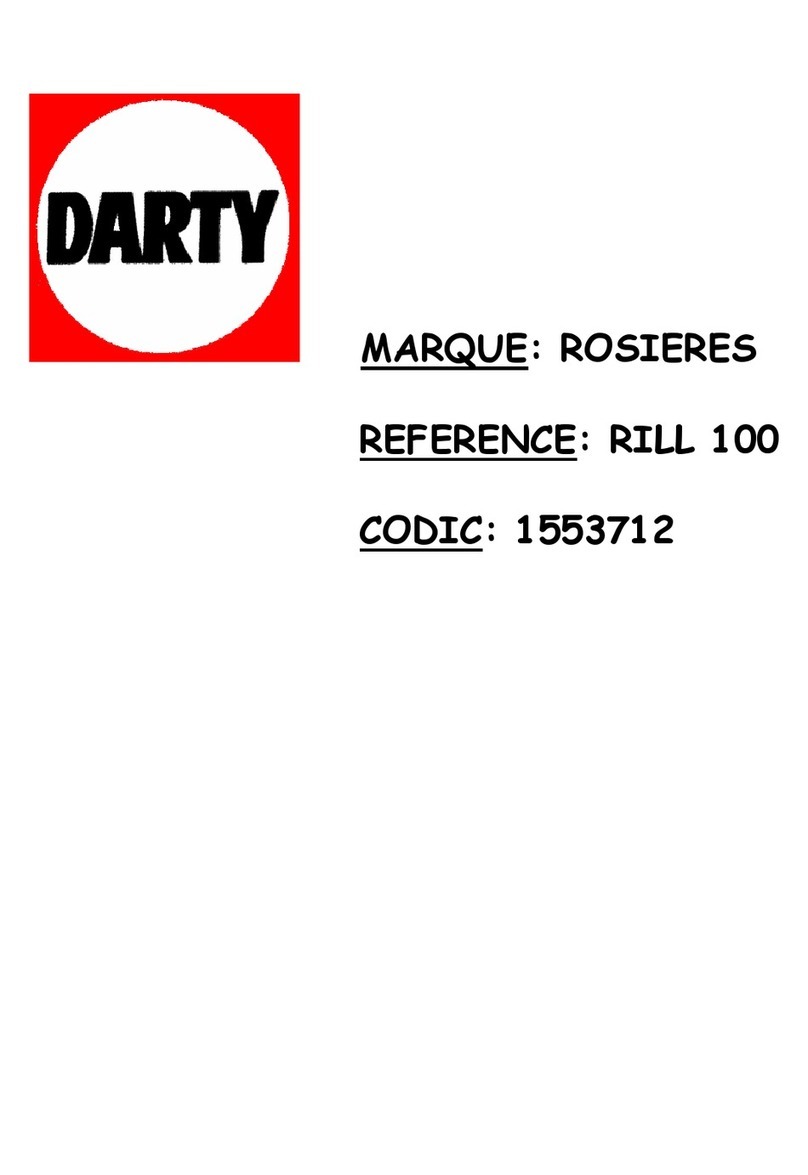
ROSIERES
ROSIERES RILL 100 H/C User instructions

Bosch
Bosch WGG256MMSN User manual and installation instructions
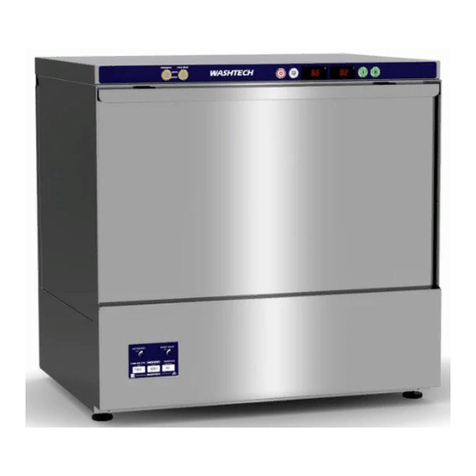
Washtech
Washtech TW Operator's manual
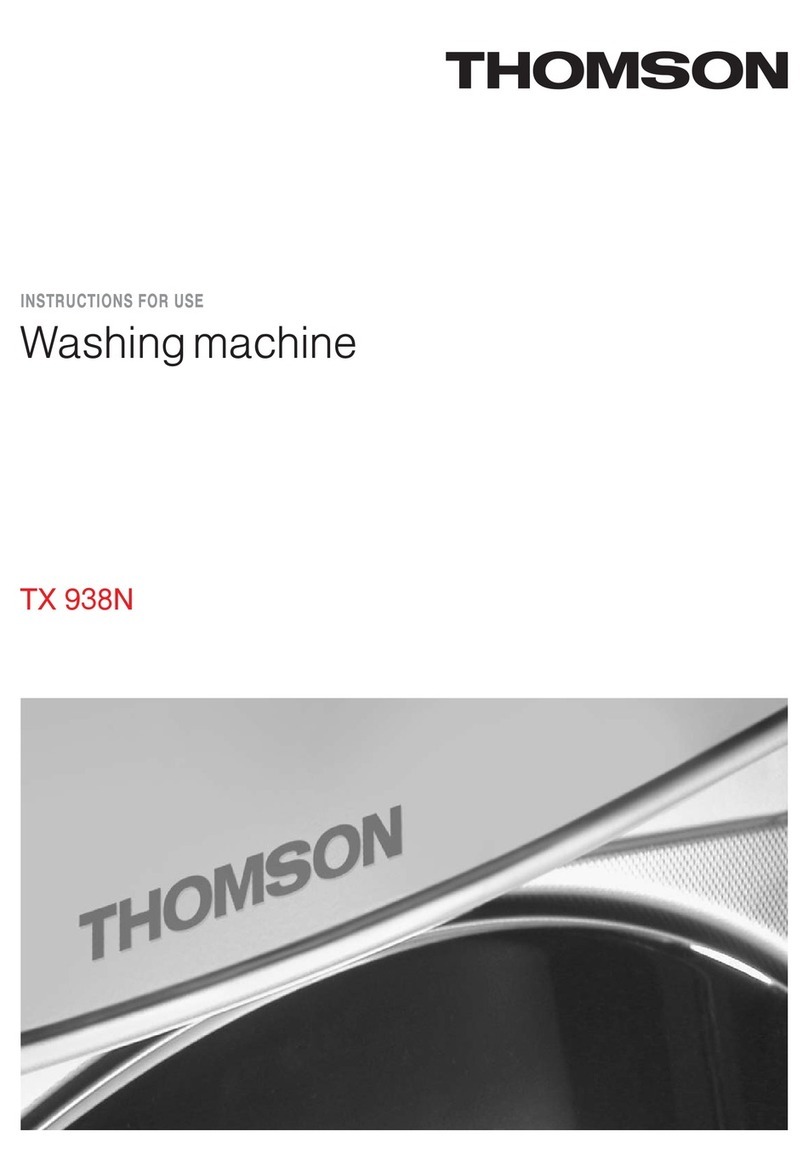
THOMSON
THOMSON TX 938N Instructions for use

Schulthess
Schulthess Merker Eco WA 4760 Bianca 305 Instruction manual and installation instructions

Zanussi
Zanussi FLS 1185 QAL Instruction booklet

